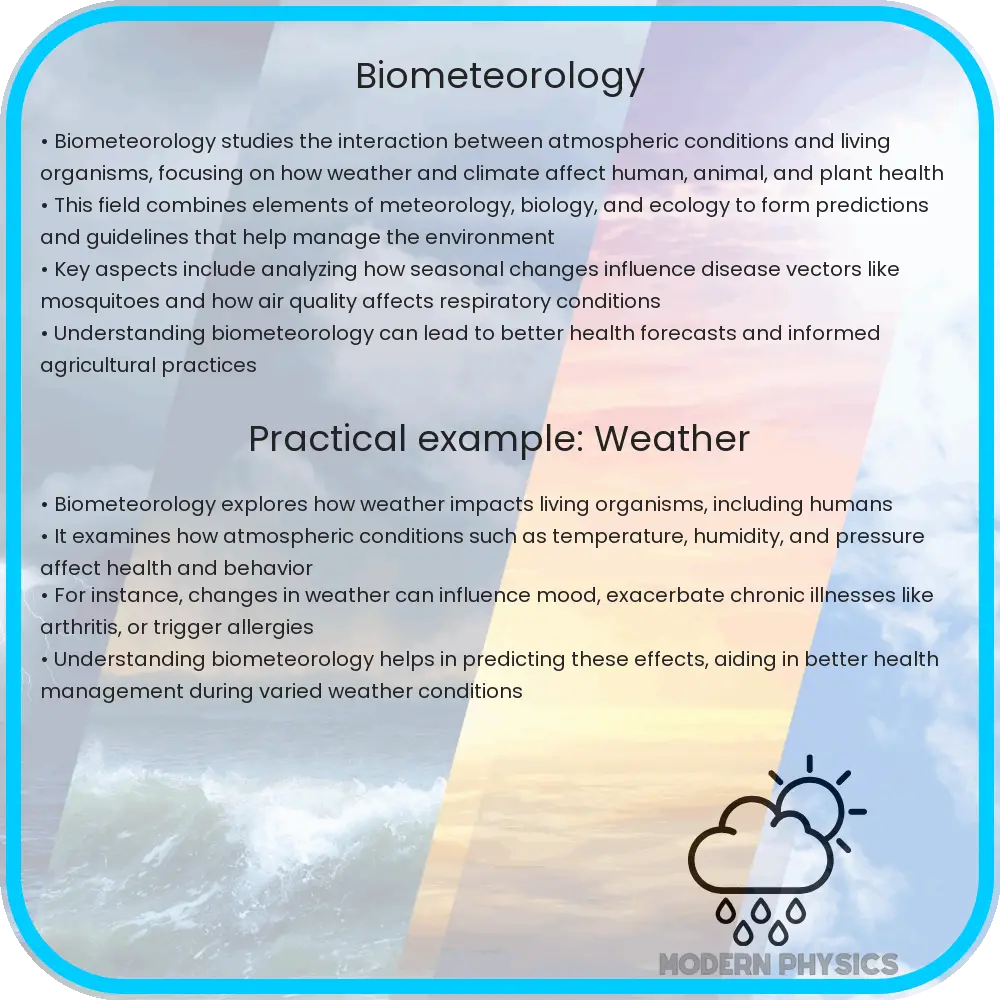Biometeorology examines how weather and climate affect the health of humans, plants, and animals, and their ecosystems.

Understanding Biometeorology: Climate Impact on Health and Ecosystems
Biometeorology is a fascinating interdisciplinary field that explores the interactions between atmospheric conditions and living organisms—humans, plants, and animals. This branch of science looks at how weather and climate affect physiological and behavioral responses that in turn influence human health and the environments we inhabit. Let’s delve into the critical aspects of biometeorology, focusing on its impacts on climate, health, and ecosystems.
Climate Impact on Health
One of the most direct ways in which climate influences health is through weather extremes. Events such as heatwaves, cold spells, hurricanes, and floods have immediate and sometimes devastating impacts on human well-being. For example, heatwaves can lead to heat stroke and dehydration, particularly affecting the elderly and those with pre-existing health conditions. On the other hand, extreme cold can increase the risk of hypothermia and respiratory diseases.
The changing climate also indirectly affects health through alterations in the distribution and intensity of vector-borne diseases. For instance, warmer temperatures can expand the habitats of mosquitoes, increasing the risk of diseases like malaria and dengue fever in regions previously unaffected.
Climate Impact on Ecosystems
Ecosystems are inherently linked to the climatic conditions of their regions, so any change in the climate can have far-reaching effects on ecosystem structure and function. Changes in temperature and precipitation patterns can alter plant blooming times, migration patterns of animals, and the availability of water resources—impacting food chains and biodiversity.
For example, higher temperatures could lead to the expansion of deserts, reducing the land available for agriculture. Similarly, changes in precipitation patterns can lead to either droughts or floods, each imposing different strains on local flora and fauna.
In aquatic systems, increased temperatures can reduce the levels of oxygen in water, stressing aquatic life. Acidification of oceans, a result of increased CO2 levels, further threatens marine biodiversity, affecting coral reefs and the species that depend on them.
- Heat and Plant Growth: Increased temperatures can accelerate the metabolism and photosynthesis in plants, but excessive heat can also stress plants, potentially reducing yields in crops vital for food security.
- Animal Migration and Reproduction: Warmer climates may change migration patterns and trigger earlier breeding seasons, disrupting the synchrony between food availability and the birth of offspring in wildlife populations.
- Vector Ecology: Climate change affects the lifecycle and distribution of vectors like ticks and mosquitoes, altering the dynamics of the diseases they can spread.
Studying Biometeorology
Researchers in biometeorology use a variety of tools and approaches to study these interactions, including satellite observations, climate models, and physical and biological sensors on the ground. By understanding the links between atmospheric conditions and biological responses, biometeorologists aim to forecast and possibly mitigate the adverse effects of climate change on health and ecosystems.
Adaptive Measures and Future Challenges
Adaptation strategies are imperative to counteract the negative impacts of climate change on health and ecosystems. These include developing heat action plans, enhancing public health surveillance, and implementing vector control programs to manage disease outbreaks. Additionally, ecosystem management strategies such as reforestation, wetland restoration, and the creation of marine protected areas can help preserve biodiversity and maintain the balance of natural habitats.
Technological advancements play a crucial role in these strategies. For instance, the integration of real-time data analysis and forecast models helps in early warning systems which can save lives during extreme weather events. Moreover, genetic engineering might offer solutions to improve crop resilience and reduce vulnerability to climate extremes.
Education and Public Awareness
Education is key in cultivating a broader understanding of biometeorological effects and fostering public engagement with climate action. Efforts to educate communities about the effects of climate change and the importance of sustainability can empower individuals to make informed decisions regarding their health and the environment.
Public awareness campaigns and programs in schools can introduce students to concepts such as renewable energy, conservation, and personal responsibility towards the environment. These programs not only educate but can also inspire future generations to participate actively in science research and sustainability initiatives.
Conclusion
Biometeorology bridges the gap between meteorology and biological sciences, offering vital insights into how climate variability affects living organisms. The impact of climate on health and ecosystems is profound and multifaceted, influencing everything from individual wellbeing to global biodiversity. By studying these interactions and implementing adaptive measures, we can better prepare for and mitigate the effects of climate change.
The field of biometeorology not only contributes to our understanding but also guides policy decisions and public health strategies. As we continue to face new challenges with climate change, the role of biometeorology will be increasingly crucial in helping society adapt to and navigate these changes. Therefore, continued research, education, and public engagement in this field are essential for a sustainable future.
